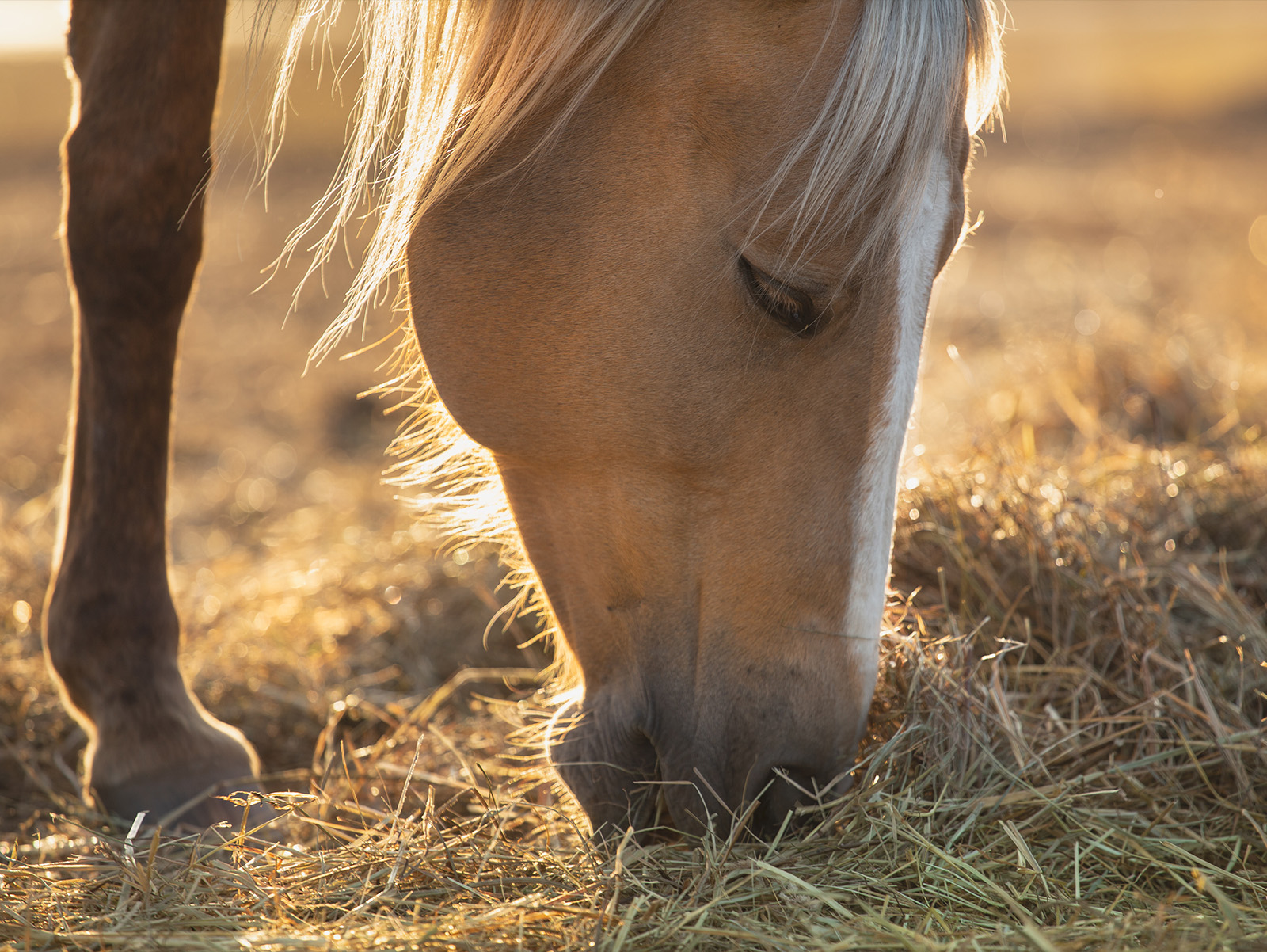Is your horse is experiencing weight loss, a lackluster coat, decreased appetite, or showing signs of irritability? These could be signs that your horse is experiencing stomach pain, usually due to gastric ulcers.
Gastric ulcers in horses, also known as Equine Gastric Ulcer Syndrome (EGUS), happen when sores develop in the soft tissue lining of the horse's stomach.
Studies show that gastric ulcers are a common problem, affecting 60-90% of performance horses, especially those who participate in high-intensity exercise, have irregular access to food, consume grains or concentrates, or are transported by trailer.
This guide will walk you through the Equine Gastric Ulcer Syndrome types, their symptoms, causes, and ways to treat them in horses.
What is Equine Gastric Ulcer Syndrome

Ulcers are painful sores that can occur in different parts of a horse's digestive tract, but they are most commonly found in the stomach and, to a lesser extent, in the hindgut. This condition is called Equine Gastric Ulcer Syndrome (EGUS), which relates to horses with stomach ulcers.
The horse's stomach is divided into two main parts: the upper squamous and lower glandular regions. The squamous area is especially susceptible to the development of ulcers.
The glandular province of the stomach produces acid, but it also generates bicarbonate and mucus to protect the tissue in that area from the acid. These substances form a barrier, making the glandular region less likely to develop ulcers.
On the other hand, the squamous region lacks these natural defenses, which is why it is the leading site of gastric ulcers, accounting for 80% of all cases.
Horses have an ongoing production of stomach acid (producing 12-15 gallons per day), which increases their risk of developing gastric ulcers, mainly the stomach is empty, and there's no food to buffer the acid.
In the wild, horses graze for up to 16 hours a day, providing them with continuous protection from ulcers because of the high-fiber food in their stomach.
However, horses kept in stalls with limited outdoor time may go for long periods without eating, leading to an empty stomach and an increased risk of developing ulcers.
Equine Gastric Ulcer Syndrome: Signs & Symptoms
How do you get to know if your horse has ulcers? The only way to diagnose Equine Gastric Ulcer Syndrome (EGUS) in your horse is through a veterinary exam, specifically a gastroscopy, where a vet will inspect the horse's stomach and upper intestine using an endoscope.
The signs and symptoms of gastric ulcers in horses can vary significantly between horses and are often non-specific. Many horse owners may notice that their horse doesn't look right.
Some common symptoms include
- Poor body condition or weight loss
- Inadequate appetite or picky eating
- Chronic diarrhea
- Bruxism or teeth gnawing
- Poor or rough coat
- Increased stereotypic behaviors such as cribbing
- A more aggressive or nervous disposition
- Poor performance
- Acute or recurrent colic
- Cinchy/Sensitivity in the girth area
Identifying the Causes of Equine Gastric Ulcer Syndrome
1. Diet and Feeding
It's not only what a horse eats but also how often and at what times they eat that affects the risk of developing ulcers. Horses are natural grazers, spending much of their day consuming roughage.
Many horses today cannot regularly graze on pasture due to current equine management practices, leading to extended periods without food in their stomachs.
This intermittent feeding, with long intervals between meals, leads to an empty stomach and the constant production of acid, which can irritate the stomach lining and cause ulcers.
Grass hay should be available 24/7, this allows for your horse to graze continually and consume forage naturally, a little at a time. This will help provide a constant stream of saliva, which helps to neutralize/buffer stomach acid. Hay bags/nets are a good option in case your horse tends to be an overly fast eater. Provide hay while hauling and at events to help reduce stress and discomfort brought on by an empty stomach.
Feeding calcium and protein rich alfalfa helps to buffer stomach acid as well.
2. High Grain Consumption
Your horse's diet can significantly impact its risk of developing ulcers. Commercial grains, for instance, are digested rapidly, leaving the stomach empty more quickly. They often provide higher levels of carbohydrates and starch, which ultimately turns to sugar which can cause irritation to the stomach if ulcers are present. No matter what grain you are feeding, try keeping portions smaller and spread out over multiple feedings.
3. Intensive Exercise
Approximately 60-90% of all performance horses are subject to Equine Gastric Ulcer Syndrome (EGUS). The frequency, severity, and number of ulcers in the squamous region of the stomach are higher due to the prolonged and intense exercise they undergo.
The high rate of gastric ulcers in performance horses can be attributed to several factors. The primary cause is increased abdominal pressure during exercise, which compacts the stomach and forces acidic contents toward the stomach's vulnerable areas.
The added stresses of travel, changes in the environment, and workload can increase the risk of ulcers.
4. Intermittent Access to Water
The lack of access to water during training and competition, especially during transport, can contribute to developing gastric ulcers in horses.
Interruptions in access to water increase the risk of ulcers in all parts of the stomach.
5. Physical Stress
Stressful events and changes to a horse's routine can trigger the release of stress hormones, leading to an increase in acid production resulting in increased risk of ulcer formation. This occurs as the elevated hormones trigger a chain reaction of hormonal changes, making the horse more vulnerable to ulcers.
Stressful situations, like traveling, environmental changes, and illness, can increase a horse's cortisol levels and its likelihood of getting ulcers.
Horses that have just recovered from an injury are also more prone to ulcers when confined to a stable.
6. Social Environment
The social environment of your horse can play a significant role in the development of ulcers. As social animals, horses are affected by the people and animals around them.
A change in the horse herd population can increase the risk of ulcers, such as adding a new horse or losing a familiar one, or changes in the health of other horses in the area.
According to research, horses that live in isolation also have a higher chance of suffering from gastric ulcers.
7. Anti-inflammatory Drugs
Using non-steroidal anti-inflammatory drugs (NSAIDs), such as phenylbutazone, for treating lameness or other illnesses can increase the risk of ulcers. If your horse has been on NSAIDs for over a week, it is at a high risk of developing gastric ulcers.
NSAIDs can lead to ulcers by reducing the production of prostaglandins, which generally promote blood flow to the stomach and help protect it with mucosal defenses.
Equine Gastric Ulcer Syndrome: Treatment
Treatment is aimed at healing the ulcers and reducing the factors that cause them. FDA approved omeprazole products such as Gastrogard® and Ulcergard® are effective in treating ulcers by reducing or turning off gastric acid secretion allowing the soft tissue/ulcerated area time to heal. Omeprazole products are given once daily and are, therefore, very convenient. Type-2 histamine (H2) blockers such as ranitidine have also been effective in treating ulcers. Histamine is a naturally-occurring chemical that stimulates cells in the stomach (parietal cells) to produce acid. H2-blockers inhibit the action of histamine on the cells, thus reducing the production of acid by the stomach.
If you want to keep your horse happy and healthy, starting with their gut and digestive heatth is a great idea. The stress from competitions and strict feeding schedules can sometimes lead to digestive issues in horses. Maintaining a healthy digestive system is crucial for your horse's overall well-being.
Ingredients that may lend support to a healthy gut and digestive system:
Research has shown that certain gastric support ingredients can be effective in supporting stomach health. Probiotics and prebiotics provide good bacteria and ‘food’ to the GI tract to help promote healthy digestive function and support a healthy immune system. Glutamine is also important to help support a natural inflammatory response and helps promote healing. Yeast supports enzyme activity for fiber digestion in the hind gut for feedstuffs that do not get digested in the small intestine, helping to stabilize digestive flora during periods of stress for overall health and performance. Adding a digestive support product can help keep your horse’s digestive system functioning properly and help promote overall health and immune function.
Gastric ulcers are a common problem that affect 60-90% of performance horses. It especially true for those horses that participate in high-intensity exercise, have irregular access to food, consume grains or concentrates, or are transported by trailer.
Always consult your veterinarian first for diagnosis, treatment and a feed plan.
Explore our gastric support supplements designed to help keep your horse’s happy, healthy and performing at the top of their game. If you have questions regarding products to best fit your horse’s needs please contact us at techservices@medvetpharm.com or call 833-809-4848.


